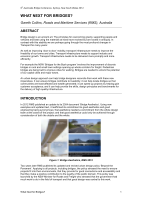Bridges

Bridge design is an ancient art. The principles for overcoming gravity, supporting people and vehicles and the best use of the materials at hand have evolved but are rooted in antiquity. In contrast with this stability we are perhaps going through the most profound changes in transport for many years.As well as improving door to door mobility, transport infrastructure needs to improve the liveability of our towns and cities. Transport infrastructure needs to support industry and economic growth. Transport infrastructure needs to be delivered more promptly and more efficiently. For example the NSW Bridges for the Bush program involves the improvement of discrete bridges in rural and small town settings opening up whole corridors for freight. Pedestrian bridges are being built to improve cities for walking. Bridges are needed to unlock the potential of our capital cities and major towns.An urban design approach can help bridge designers reconcile their work with these new imperatives. It can ensure bridges contribute to liveability; it can help locate bridges so that communities are least affected and wealth generated; it can speed-up projects by helping gain customer acceptance; and it can help provide the skills, design principles and benchmarks for the delivery of high quality infrastructure.
Related publications
WEB-AGBT07-24
Latest Bridges News
